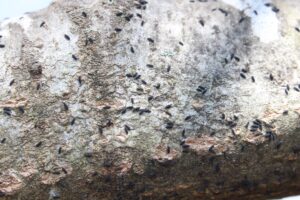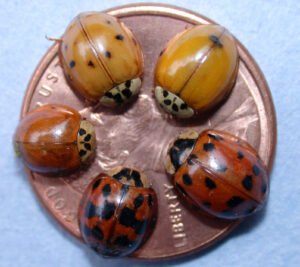This past February was among the coldest and snowiest we had since 2014. Yet despite our discomfort, it won’t be an issue for most insect pests that attack landscape plants. Most species regularly survive winters that are far colder. Indeed, the snow cover probably protected many insects from freezing in this year’s winter weather.

Snowfleas on white bark in February. (Photo by Photo by Matthew Fleck, Jasper County, Indiana Parks and Rec).
Insects are cold blooded animals that have many ways of surviving freezing temperatures. Generally speaking, they use proteins and sugar alcohols that lower their freezing point and prevent ice crystals from damaging sensitive tissues. As such it, is not much different from the process that gives us runny noses on cold days to keep our noses from freezing.
Snowfleas are in a group of wingless insects called springtails. This species produces special antifreeze proteins to keep the snowfleas from freezing and allows them to feed in winter even when there is snow on the ground.
Many species of aphids that feed on herbaceous plants in the summer will feed on woody plants in the fall to ingest sugar alcohols that can be deposited into eggs and act as antifreeze.

Eggs of soybean aphid winter of stems of buckthorn contained antifreeze made from chemicals produced by this shrub. (Photo by J. Obermeyer)
Insects require energy and time to become fully adapted to cold temperatures. For this reason, they are most able to survive the cold when insects have time to adapt to cold gradually and stay adapted for the duration of winter. Fluctuating temperatures in the fall make it difficult for insects to rely only on temperature to start their hibernation process. Many species use the shortening days of late summer and autumn to guide them to enter a resting state, called diapause, that helps survive the winter.
In the spring when you dig up your garden you can find many insects that overwinter in the soil. These can include many pests, like the white grub stage of Japanese beetles, wireworms, cutworm caterpillars, and even pupae of hornworms. Fortunately, these pests share the soil with beneficial insects like ground beetles and ants that feed on pests as the weather warms. The soil insulates all these insects from weather extremes that cause rapid changes in soil temperature. A blanket of snow on the ground will reflect light and keep the soil temperatures even more constant and increase the likelihood of insect survival.

When multicolored Asian lady beetles winter in attics and wall voids of houses they can become a nuisance. Their survival this winter will help control many pests (Photo by J. Obermeyer).
Insects that winter as adults seek hollow logs or caverns for shelter that can buffer them from weather extremes. Around the time of the first frost, adult multicolored Asian ladybeetles and brown marmorated stink bugs will seek shelter in barns, attics, and wall voids to hibernate in our homes. Heat from our homes can confuse them and cause them to come out of hibernation and become pests in our homes.
Insects are much less able to tolerate rapid cold snaps called Arctic clippers than a long cold February. Warmer winters and punctuated by short intense cold periods and late spring frosts can kill insects who have been lulled out of winter dormancy just in time to be frozen.
In conclusion, although February’s cold and snow did not kill the pests of 2021, they also spared the beneficial insects that can help them from becoming pests on landscape trees and shrubs. More importantly, the deep snow cover has likely provided them with moisture plants will need to thrive in the coming year.
Reference
Bale, J.S. and S. A L Hayward 2010. Insect overwintering in a changing climate. Journal of Experimental Biology 213:980-994.
Graham, L. A. and P.L. Davies 2005. Glycine-rich antifreeze proteins from snow fleas. Science. 310:5747 pp 461.